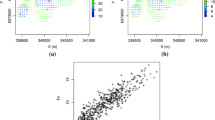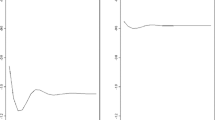Abstract
Models for the analysis of multivariate spatial data are receiving increased attention these days. In many applications it will be preferable to work with multivariate spatial processes to specify such models. A critical specification in providing these models is the cross covariance function. Constructive approaches for developing valid cross-covariance functions offer the most practical strategy for doing this. These approaches include separability, kernel convolution or moving average methods, and convolution of covariance functions. We review these approaches but take as our main focus the computationally manageable class referred to as the linear model of coregionalization (LMC). We introduce a fully Bayesian development of the LMC. We offer clarification of the connection between joint and conditional approaches to fitting such models including prior specifications. However, to substantially enhance the usefulness of such modelling we propose the notion of a spatially varying LMC (SVLMC) providing a very rich class of multivariate nonstationary processes with simple interpretation. We illustrate the use of our proposed SVLMC with application to more than 600 commercial property transactions in three quite different real estate markets, Chicago, Dallas and San Diego. Bivariate nonstationary process inodels are developed for income from and selling price of the property.
Similar content being viewed by others
References
Agarwaal, D. andGelfand, A. E. (2004). Slice Gibbs sampling for simulation based fitting of spatial data models.Statistics and Computing. To appear.
Aitchison, J. (1987).The Statistical Analysis of Compositional Data. Chapman & Hall, London.
Banerjee, S., Carlin, B. P., andGelfand, A. E. (2004).Hierarchical Modeling and Analysis for Spatial Data. Chapman-Hall CRC Press, Boca Raton.
Banerjee, S. andGelfand, A. E. (2002). Prediction, interpolation and regression for spatial misaligned data points.Sankhya, 64:227–245.
Benjamin, J. andSirmans, G. S. (1991). Determinants of apartment rent.Journal of Real Estate Research, 6:357–379.
Berliner, L. M. (2000). Hierarchical bayesian modeling in the environmental sciences.Allgemeine Statistiche Archiv (Journal of the German Statistical Society), 84:141–153.
Box, S. E. P. andTiao, S. C. (1992).Bayesian Inference in Statistical Analysis. John Wiley and Sons, New York.
Brown, P. J., Le, N. D., andZidek, J. V. (1994). Multivariate spatial interpolation and exposure to air pollutants.The Canadian Journal of Statistics, 22(4):489–509.
Browne, W., Draper, D., andGoldstein, H. (2002). Bayesian and likelihood methods for fitting multilevel models with complex level-1 variation.Computational Statistics and Data Analysis. To appear.
Calder, C. A. (2003).Exploring Latent Structure in Spatial Temporal Processes Using Process Convolutions. Ph.D. thesis, Institute of Statistics and Decision Sciences, Duke University, Durham, North Carolina, USA.
Cressie, N. A. C. andHuang, H. C. (1999). Classes of nonseparable spatio-temporal stationary covariance functions.Journal of the American Statistical Association, 94:1330–1340.
De Iaco, S., Myers, D. E., andPosa, D. (2003). The linear coregionalization model and the product-sum space-time variogram.Mathematical Geology, 35(14):25–38.
Fuentes, M. (2001). A new high frequency kriging approach for nonstationary environmental processes.Environmetrics, 12:469–483.
Fuentes, M. (2002a). Modeling and prediction of nonstationary spatial processes.Biometrika, 2:281–298.
Fuentes, M. (2002b). Spectral methods for nonstationary spatial processes.Biometrika, 89:197–210.
Fuentes, M. andSmith, R. L. (2001). A new class of nonstationary spatial models. Tech report, North Carolina State University, Raleigh.
Gaspari, G. andCohn, S. E. (1999). Construction of correlation functions in two and three dimensions.Quarterly Journal of the Royal Meterological Society, 125:723–757.
Gelfand, A. E., Banerjee, S., andGamerman, D. (2004). Spatial process modelling for univariate and multivariate dynamic spatial data.Environmentrics. Forthcoming.
Gelfand, A. E. andGhosh, S. K. (1998). Model choice: A minimum posterior predictive loss approach.Biometrika, 85:1–11.
Gelfand, A. E. andVounatsou, P. (2002). Proper multivariate conditional autoregressive models for spatial data analysis.Biostatistics, 4:11–25.
Geltner, D. andMiller, N. G. (2001).Commercial Real Estate Analysis and Investments. South-Western, Cincinnati.
Gneiting, T. (2002). Nonseparable, stationary covariance functions for space-time data.Journal of the American Statistical Association, 97:590–600.
Gotway, C. A. andHartford, A. H. (1996). Geotatistical methods for incorporating auxiliary information in the prediction of spatial variables.Journal of Agricultural, Biological, and Environmental Statistics, 1(1):17–39.
Goulard, M. andVoltz, M. (1992). Linear coregionalization model: Tools for estimation and choice of cross-variogram matrix.Mathematical Geology, 24:269–286.
Grzebyk, M. andWackernagel, H. (1994). Multivariate analysis and spatial/temporal scales: Real and complex models. InProceedings of the XVIIth International Biometrics Conference, pp. 19–33. Hamilton, Ontario.
Harville, D. A. (1997).Matrix Algebra from a Statistician's Perspective. Springer, New York.
Higdon, D. (1998). A process-convolution approach to modeling temperatures in the North Atlantic Ocean.Journal of Environmental and Ecological Statistics, 5:173–190.
Higdon, D., Lee, H., andHolloman, C. (2002). Markov chain Monte Carlo based ap-proaches for inference in computational intensive problems. In J. M. Bernardo and J. O. Berger, eds.,Bayesian Statistics 7, Proceedings of the Seventh Valencia Meeting.
Higdon, D., Swall, J., andKern, J. (1999). Non-stationary spatial modeling. In J. M. Bernardo and J. O. Berger, eds.,Bayesian Statistics 6, Proceedings of the Sixth Valencia Meeting, pp. 761–768.
Kinnard, W. N. (1971).Income Property Valuation. Lexington Press, Lexington, MA.
Liu, F. (2000).Bayesian Time Series: Analysis Methods Using Simulation Based Computation. Ph.D. thesis, Institute of Statistics and Decision Sciences, Duke University, Durham, North Carolina, USA.
Lusht, K. M. (1997).Real Estate Valuation. Irwin, Chicago.
Majumdar, A. andGelfand, A. E. (2004). Multivariate spatial modeling using convolved covariance functions. Tech report, Institute of Statistics and Decision Sciences, Duke University, USA. Submited.
Mardia, K. V. (1988). Multi-dimensional multivariate Gaussian Markov random fields with application to image processing.Journal of Multivariate Analysis, 24:265–284.
Mardia, K. V. andGoodall, C. R. (1993). Spatial-temporal analysis of multivariate environmental monitoring data. In G. P. Patil and C. R. Rao, eds.,Multivariate Environmental Statistics, pp. 347–386. Elsevier Science Publishers.
Matérn, B. (1986).Spatial variation, vol. 36 ofLecture Notes in Statistics. Springer-Verlag, Berlin, 2nd ed.
Matheron, G. (1982). Pour une analyse krigeante des données régionaliśees. Tech report, Ecole Nationale Supérieure des Mines de Paris, Paris.
Muirhead, R. J. (1982).Aspects of Multivariate Statistica Theory, John Wiley and Sons, New York.
Neal, R. (2002). Slice sampling.Annals of Statistics. To appear.
Paciorek, C. J. andSchervish, M. J. (2004). Nonstationary covariance functions for Gaussian process regression.Advances in Neural Information Processing Systems, 16:1–8.
Royle, J. A. andBerliner, L. M. (1999). A hierarchical approach to multivariate spatial modeling and prediction.Journal of Agricultural, Biological and Environmental Statistics, 4:29–56.
Ryti, R. T., Neptune, B., andGroskinsky, B. (1992). Superfund soil cleanup: Applying the Piazza Road remediation plan.Environmental testing and Analysis, 1:26–31.
Sansó, B. andSchmidt, A. M. (2004). Spatio-temporal models based on discrete convolutions. Tech. Rep. ams2004-06, Department of Applied Mathematics and Statistics, University of California Santa Cruz.
Schmidt, A. andGelfand, A. E. (2003). A Bayesian coregionalization model for multivariate pollutant data.Journal of Geophysics Research-Atmospheres, 108(D24):8783.
Schmidt, A. M. andO'Hagan, A. (2003). Bayesian inference for nonstationary spatial covariance structure via spatial deformations.Journal of the Royal Statistical Society, 65:745–758.
Spiegelhalter, D., Thomas, A., Best, N., andGilks, W. (1996). Bugs 0.5 Bayesian inference using Gibbs sampling. Manual, version ii, MRC Biostatistics Unit, nstitute of Public Health, Cambridge, UK.
Stein, M. L. (1999).Interpolation of Spatial Data, Springer-Verlag, New York.
Sun, W., Le, N. D., Zidek, J. V., andBurnett, R. (1998). Assessment of a Bayesian multivariate interpolation approach for health impact studies.Environmetrics, 9:565–586.
Titman, S., Tompaidis, S., andTsyplakov, S. (2001). Market imperfections, investment optionality and default spreads. Technical report, University of Texas, Austin.
Vargas-Guzmán, J. A., Warrick, A. W., andMyers, D. (2002). Coregionalization by linear combination of nonorthogonal components.Mathematical Geology, 34:405–419.
Ver Hoef, J. M. andBarry, R. D. (1998). Constructing and fitting models for cokriging and multivariable spatial prediction.Journal of Statistical Planning and Inference, 69:275–294.
Ver Hoef, J. M. C., C. N. A., andBarry, R. P. (2004). Flexible spatial models based on the fast Fourier transform (FFT) for cokriging.Journal of Computational and Graphical Statistics. To appear.
Wackernagel, H. (2003).Multivariate Geostatistics—An Introduction with Applications. Springer-Verlag, New York, 3rd ed.
West, M., andHarrison, J. (1989).Bayesian Forecasting and Dynamic Models. Springer Verlag, New York.
Author information
Authors and Affiliations
Corresponding author
Additional information
The work of the first and second authors was supported in part by NIH grant R01ES07750-06.
Rights and permissions
About this article
Cite this article
Gelfand, A.E., Schmidt, A.M., Banerjee, S. et al. Nonstationary multivariate process modeling through spatially varying coregionalization. Test 13, 263–312 (2004). https://doi.org/10.1007/BF02595775
Received:
Accepted:
Issue Date:
DOI: https://doi.org/10.1007/BF02595775
Key Words
- Cross-covariance function
- linear model of coregionalization
- matric-variate Wishart spatial process
- prior parametrization
- spatial range
- spatially varying process model




